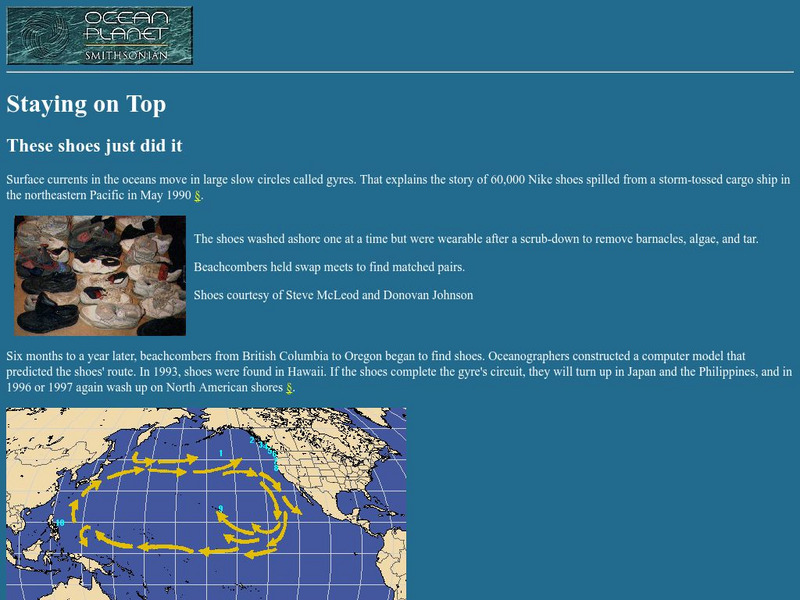Smithsonian Institution
National Museum of Natural History: Ocean Planet: In Search of Giant Squid
An on-line exhibit archived from a Smithsonian exhibit explores and interprets the facts and myths surrounding giant squids - the world's largest invertebrates.
Smithsonian Institution
National Museum of Natural History: Ocean Planet: Water Pollution Toxic Materials
This site, from an archived Smithsonian exhibit, describes and illustrates the effects of toxic materials on wildlife in bodies of water.
Space Telescope Science Institute
Space Telescope Science Institute: Hubble Site
Explore the universe and celestial phenomena made visible by Hubble. High-quality photos of planets, stars, nebulae, and galaxies, complete with individual descriptions, can be viewed online and downloaded for printing and personal use.
NASA
Nasa: Welcome to the Planets Magellan
An overview of the Magellan Mission from the assembly of the spacecraft to its radar mapping of Venus. Includes photographs and descriptions of the different phases of the mission. Streaming audio of the descriptions are also available.
NASA
Nasa: Welcome to the Planets Mariner 10
This web page contains images and information on the Mariner 10 space mission. The information is available in audio format.
NASA
Nasa: Welcome to the Planets Viking 1 & 2
Images and a description of the Viking mission to Mars can be found here. The descriptions are also available in audio format.
NASA
Nasa: Welcome to the Planets Hubble
On this site, you will find information and images pertaining to the primary mirror, launch, and deployment of the Hubble Space Telescope. The information is presented in text and audio format.
NASA
Nasa: Welcome to the Planets Earth
Images of specific locations on the surface of the Earth, taken from space, along with descriptive captions.
NASA
Nasa Star Child: Neptune, the Blue Planet (Level 1)
An introduction to Neptune for young students. Audio content, a glossary, graphics, and a printable version are all included.
NASA
Nasa: Io: Overview: Volcanic Moon
Find out about most volcanically active world in the Solar System, Jupiter's moon named Io.
NASA
Nasa: Deimos: Overview
This site provides statistical information and information on the physical features of Deimos.
Curated OER
Nasa's the Space Place: Solar System: Pluto's Orbit
An illustration showing Pluto's and the other planet's orbits around the sun.
NASA
Astronomical Society of the Pacific: Telescope Treasure Hunt
This hands-on astronomy activity lets learners hunt for different objects in the night sky that contribute to stellar and planetary formation, using a Treasure List. They will learn how stars and their planets form and will find objects...
NASA
Nasa Star Child: The Planet Earth
Facts about the Earth including its orbit, its atmosphere, and its landforms. Includes a discussion question on seasons, with facts about them, and the answer. A linked page covers similar material in a "Level 2" version, and has a...
NASA
Nasa: Launch a Rocket From a Spinning Planet
This site from the National Aeronautics and Space Administration provides a fun project on rockets. "Nothing in space stands still. Everything either orbits around something else, or moves toward or away from something else. So how do...
PBS
Pbs Learning Media: Seasons on Earth and Mars
Compare the seasons on Earth and Mars with NASA imagery. Use this resource to visualize how the axial tilt of a planet influences its seasons and to compare data about seasonal changes on Earth and Mars. Support materials include:...
Curated OER
Nasa Logo
A portal to resources on the sun, the Earth's neighboring planets, and the weather in space. Find out why Saturn is the "jewel of the Solar System" and explore what happens when Venus and Mercury make their rare transits across the sun.
Smithsonian Institution
Smithsonian Learning Lab: The Universe, an Introduction
Start with the questions all students ask: How big is the universe, how far away are the planets and stars, how did they form and when, how do they move and why? Build on their natural curiosity. The Smithsonian, in cooperation with...
Johns Hopkins University
New Horizons Website
This site from the Solar System Exploration section of NASA provides an overview of the space mission to Pluto, Charon, and the fringes of our Solar System. It describes the Kuiper Belt, and the objects involved with it, provided links...
DOGO Media
Dogo News: Week of 10 21 13: Does It Rain Diamonds on Saturn and Jupiter?
Article reports on research that suggests that rain on Saturn and Jupiter may be made of diamonds. Includes a brief video.
NASA
Nasa: Our Restless Planet
This animation library is a great resource for a diverse list of earth science topics including: tsunamis, land subsidence, magnetic fields, volcanoes earthquakes, floods, and sea level changes.
Smithsonian Institution
National Museum of Natural History: Ocean Planet: Biological Roulette: Alien Species
Click on the roulette wheel and see how some alien species were introduced into the United States and the effect they have had on our country. This is part of an archived Smithsonian exhibit.
Smithsonian Institution
National Museum of Natural History: Ocean Planet: Oil Pollution
Source provides key facts and figures as well as pictures on various oil accidents. Site information is divided up into three categories: Sources, Accidents and Cleanups. This is part of an archived Smithsonian exhibit.
Smithsonian Institution
National Museum of Natural History: Ocean Planet: Staying on Top
This is the story of the infamous Nike shoes that washed off a cargo ship. The shoes later showed up along beaches, giving oceanographers another clue as to how ocean currents move.














